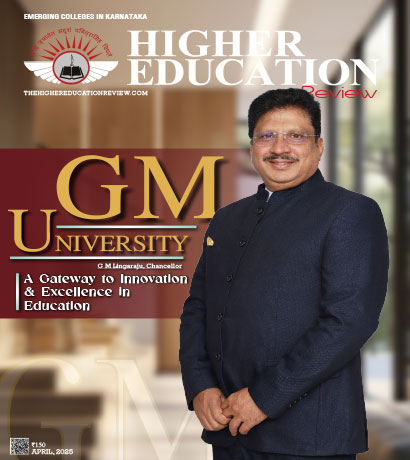How Technology Can Be Utilized For High-Impact Learning

Sandeep Dham, COO
The onset of the COVID-19 pandemic led to a massive digital transformation that swept through homes and workplaces alike. As parents, students and teachers tried to wrap their heads around the lingering effects of the pandemic on learning outcomes and student well-being, technology came to the rescue of millions of students globally creating a levelplaying field that addressed long-standing inequities in education. Almost overnight, remote learning became the buzzword as students and teachers huddled into online classrooms to leverage a plethora of digital tools for highimpact learning.
While the pandemic is a thing of the past now, technology can still play a big role in increasing student engagement, enhancing learning experience and improving educational outcomes. Technology can also help teachers create a more enriching learning environment for their students by delivering lessons through videos, digital textbooks, podcasts, multi-coloured charts, and images. According to a recent report by the world economic forum, India can build on the digital solutions tested and adopted during the pandemic to take education to all and prepare Indian school students for success in the 21st century. India�s New Education Policy 2020 also aims to improve the delivery of quality education for all learners, including through digital means.
Based on their aptitude and interests, students meet academic milestones at different paces. However, technology can play a critical role in designing strategies that can help students make the most of their online learning experience. A few of them have been discussed here.
1. Multi-Sensory Learning:- As the name suggests, this approach to teaching involves engaging several regions of the brain. Combining aural or visual components that includes listening to the concepts while also viewing them in the form of pictures can aid in faster, higher impact learning. Besides audio or visual multimedia, multisensory learning could also include tactile, smell and taste-related materials. For instance, using clay to make models as part of the lesson plan or delivering content through storytelling coupled with enactment, as and when required.
2. Embedded Learning: - This �learning by doing� approach is a powerful tool deployed by teachers to help students deep dive for greater understanding of concepts and context.
This could involve experts demonstrating live projects over digital platforms or students trying it out themselves in a hybrid learning mode. The goal of embedded learning is to strengthen the foundation on which students can build upon through projects and 3D models.
3. Visual Learning: - Tech-based visual learning has grown dramatically in the last few years. It helps students to visualise complex concepts, instead of learning by rote without understanding. Using 3D videos and 3D simulations elevates learning of maths and science concepts. It is more than just what the person sees but how they see it. Augmented reality and virtual reality (AR/VR) technologies are opening up new frontiers in creating a rich learning experience that is more immersive and advanced. For example, students of biology can use technological simulations to gain useful insights into the world of plants, animals and insects.
4. Digital Learning:- Technology has helped democratise education, giving students greater control over time, path and pace at which they learn. The proliferation of a range of internet access devices has ensured that learning is no longer confined to the four walls of the classrooms. The use of multicoloured charts and videos has provided much-needed aid to teachers to retain the interest of their students even if they are at remote locations. This has led to creation of a wide variety of digital content that can be accessed on laptops, tablets and smartphones, much to the delight of the tech-savvy young generation.
5. Personalised Learning:- Teachers matter enormously to student learning. Technology is empowering teachers with insights and data that can be effectively leveraged to provide customised support and individual learning paths to all students. Across educational institutions, teachers are actively using technology to build personalised lesson plans, employ online videos, images and articles for class demonstrations. Digital resources such as cloud computing and advanced analytics are being used to make education more inclusive and student-centric.
6. Battle Exam Phobia:- Every year, stress becomes more overpowering for students before and after the exams. A recent study showed that among the students preparing for medical entrance exams, more than 70 percent experienced high levels of stress that led to poor concentration and lack of focus. However, this fear can be drastically reduced by using an exam simulator that delivers computer-adaptive tests to create an environment where students get the experience of the real exam format. Online assessments with instant feedback help boost confidence and motivate students to attempt the exams with ease. According to a study, online testing reduces test �threat� while increasing time spent on class instruction and reflection. Parents, teachers and psychologists have an important role in helping children cope with exam stress and anxiety. They can do so by setting realistic expectations, motivating them to carve out time for regular exercise and play, and counseling them whenever they feel overwhelmed.
7. Doubt Support:- Artificial Intelligence has the power to solve some of the most pressing challenges in education. With the use of AI, in case a student has any doubts, they can be automatically directed to pre-recorded video, audio or written content created in advance by teachers or subject matter experts. Similarly, the use of chatbots can help provide a 24x7 assistance to students without actively involving a teacher to clear doubts and address queries.
In today�s fast-paced competitive environment, an effective learning strategy, complemented by a judicious use of technology can go a long way in defining success and building a strong foundation for students. Information sharing in real-time with parents and key stakeholders, and continuous assessments and revision of concepts in a digital environment go a long way in supporting the learning process. Digital tools are useful enablers for faster query resolution and computer-adaptive practice sessions are changing the way we learn. It is high time students, parents and teachers come together to create a more meaningful and cost-effective learning environment that is built on a strong technological foundation
While the pandemic is a thing of the past now, technology can still play a big role in increasing student engagement, enhancing learning experience and improving educational outcomes. Technology can also help teachers create a more enriching learning environment for their students by delivering lessons through videos, digital textbooks, podcasts, multi-coloured charts, and images. According to a recent report by the world economic forum, India can build on the digital solutions tested and adopted during the pandemic to take education to all and prepare Indian school students for success in the 21st century. India�s New Education Policy 2020 also aims to improve the delivery of quality education for all learners, including through digital means.
Based on their aptitude and interests, students meet academic milestones at different paces. However, technology can play a critical role in designing strategies that can help students make the most of their online learning experience. A few of them have been discussed here.
1. Multi-Sensory Learning:- As the name suggests, this approach to teaching involves engaging several regions of the brain. Combining aural or visual components that includes listening to the concepts while also viewing them in the form of pictures can aid in faster, higher impact learning. Besides audio or visual multimedia, multisensory learning could also include tactile, smell and taste-related materials. For instance, using clay to make models as part of the lesson plan or delivering content through storytelling coupled with enactment, as and when required.
2. Embedded Learning: - This �learning by doing� approach is a powerful tool deployed by teachers to help students deep dive for greater understanding of concepts and context.
This could involve experts demonstrating live projects over digital platforms or students trying it out themselves in a hybrid learning mode. The goal of embedded learning is to strengthen the foundation on which students can build upon through projects and 3D models.
3. Visual Learning: - Tech-based visual learning has grown dramatically in the last few years. It helps students to visualise complex concepts, instead of learning by rote without understanding. Using 3D videos and 3D simulations elevates learning of maths and science concepts. It is more than just what the person sees but how they see it. Augmented reality and virtual reality (AR/VR) technologies are opening up new frontiers in creating a rich learning experience that is more immersive and advanced. For example, students of biology can use technological simulations to gain useful insights into the world of plants, animals and insects.
4. Digital Learning:- Technology has helped democratise education, giving students greater control over time, path and pace at which they learn. The proliferation of a range of internet access devices has ensured that learning is no longer confined to the four walls of the classrooms. The use of multicoloured charts and videos has provided much-needed aid to teachers to retain the interest of their students even if they are at remote locations. This has led to creation of a wide variety of digital content that can be accessed on laptops, tablets and smartphones, much to the delight of the tech-savvy young generation.
5. Personalised Learning:- Teachers matter enormously to student learning. Technology is empowering teachers with insights and data that can be effectively leveraged to provide customised support and individual learning paths to all students. Across educational institutions, teachers are actively using technology to build personalised lesson plans, employ online videos, images and articles for class demonstrations. Digital resources such as cloud computing and advanced analytics are being used to make education more inclusive and student-centric.
6. Battle Exam Phobia:- Every year, stress becomes more overpowering for students before and after the exams. A recent study showed that among the students preparing for medical entrance exams, more than 70 percent experienced high levels of stress that led to poor concentration and lack of focus. However, this fear can be drastically reduced by using an exam simulator that delivers computer-adaptive tests to create an environment where students get the experience of the real exam format. Online assessments with instant feedback help boost confidence and motivate students to attempt the exams with ease. According to a study, online testing reduces test �threat� while increasing time spent on class instruction and reflection. Parents, teachers and psychologists have an important role in helping children cope with exam stress and anxiety. They can do so by setting realistic expectations, motivating them to carve out time for regular exercise and play, and counseling them whenever they feel overwhelmed.
7. Doubt Support:- Artificial Intelligence has the power to solve some of the most pressing challenges in education. With the use of AI, in case a student has any doubts, they can be automatically directed to pre-recorded video, audio or written content created in advance by teachers or subject matter experts. Similarly, the use of chatbots can help provide a 24x7 assistance to students without actively involving a teacher to clear doubts and address queries.
In today�s fast-paced competitive environment, an effective learning strategy, complemented by a judicious use of technology can go a long way in defining success and building a strong foundation for students. Information sharing in real-time with parents and key stakeholders, and continuous assessments and revision of concepts in a digital environment go a long way in supporting the learning process. Digital tools are useful enablers for faster query resolution and computer-adaptive practice sessions are changing the way we learn. It is high time students, parents and teachers come together to create a more meaningful and cost-effective learning environment that is built on a strong technological foundation

